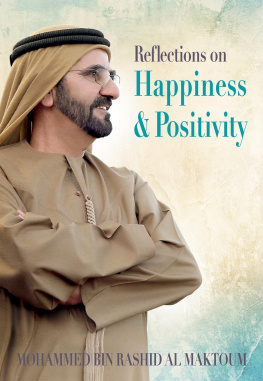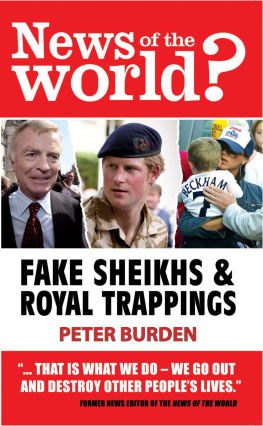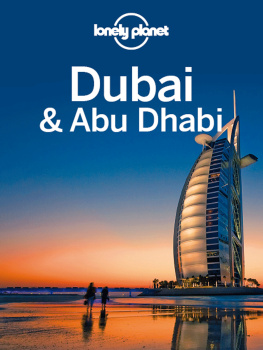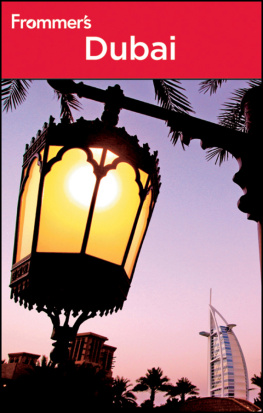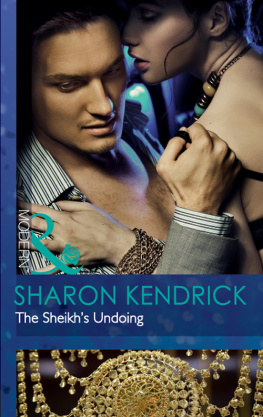About the author
Tom Steinfort is an award-winning journalist, currently working as a reporter for 60 Minutes . Hes become a familiar face on Australian television over the last seventeen years, having previously been a newsreader on the Today Show and, prior to that, a foreign correspondent for Nine in both Europe and the USA. His remarkable career has seen him watch history unfold in more than forty countries, from reporting from North Korea during the nuclear missile crisis, to covering Oscar Pistoriuss murder trial in South Africa, to following Donald Trump across America during the presidential campaign in 2016.
About the Book
Dubai is feted internationally as a beacon of modernity: glittering skyscrapers, a cultural melting pot, host to high-profile sporting events its even a new player in the space race. The citys ruled by Sheikh Mohammed bin Rashid Al Maktoum, an all-powerful multibillionaire who counts the Queen and Donald Trump as friends. But his kingdoms progressive propaganda defies a dark underbelly. And nowhere is that more apparent than in the Sheikhs own palace.
Two of the Sheikhs daughters have attempted daring escapes from their fathers iron rule, dreaming of a better life. Sheikha Latifa released her own extraordinary tell-all videos online, and the Sheikhs youngest wife, Princess Haya bint Hussein, caused further scandal by laying out the Maktoum dynastys dirty laundry in Londons High Court.
Sheikh Mohammeds attitudes towards women and human rights dont stop at the palace gates they are reflected across the UAE, despite the country spending a fortune to promote itself as a model of harmony and equality. Here, women are still considered a possession. They are the ones charged if they report a rape. There is no minimum wage for workers. Corruption is commonplace. Censorship is rife.
Award-winning 60 Minutes reporter Tom Steinfort has spent years uncovering the sins of Sheikh Mohammed, and the disturbing reality of life in Dubai. Now, he shares the brave stories of those who have experienced the horror firsthand, and trusted him to share the truth.
The Middle East is home to more historic cities than just about any other region in the world. From Jerusalem to Cairo, Mecca to Medina, Baghdad to Beirut, the region is littered with locations that have shaped the world for not just centuries, but many millenniums. And then theres Dubai. While so many other metropolises in the Gulf were creating history, Dubai didnt rate a mention. The sands of time seemingly swept over this desert backwater. Even by the early 1900s, Dubai was little more than a mud outpost, home to villagers whose living conditions were comparable with some of the poorest parts of Africa. Now the city is a world leader on so many fronts: aviation, finance and lately even the space race. The rapid evolution of Dubai has led to a city that finds itself somewhat conflicted trying to be a beacon of modernity and prosperity, while also maintaining its ultraconservative Islamic traditions, which often appal human rights observers. In many respects the prosperity helps distract from the at times medieval traditions. And that is key to understanding this conflicted kingdom... when you start to appreciate just how far the United Arab Emirates has come in recent decades, you also begin to realise why plenty of locals are happy to look the other way when human rights issues arise. The good times for so many outweigh the bad deeds of a powerful few.
Historic records in Dubai barely date back to before the 1800s quite extraordinary when you compare that to a neighbouring nation like Saudi Arabia. That country is considered a key stepping stone in the colonisation of Eurasia from Africa somewhere between 75 000 to 125 000 years ago, during the Stone Age. Yet Dubais documented history spans a measly 0.21 per cent of that period. So many great empires have stamped their footprint on the Middle East since man made that momentous migration from Africa. Think of the might and ingenuity of the Egyptians, the longevity of the Assyrians, the dominance and cultural significance of the Romans, not to mention the Ottomans and so many others who would leave a lasting legacy through these lands. And yet as each of those dynasties sought cities to conquer, the backwater of Dubai would barely, if ever, cross the radar as a town of any interest. For an eternity, Dubai was about as popular as a bag of brussels sprouts in a chocolate shop. They have enjoyed the safety of the undesired, and have lived lives to which a hundred generations have specialised them, in conditions barely tolerable to others, remarked British military administrator Stephen Longrigg in 1949 when pondering how the UAE had avoided the never-ending triumphs and turmoil of neighbouring cities. Its a very valid point he makes about the conditions if youve ever been to Dubai in the peak of summer, you fully appreciate that living there in an era before air-conditioning would have been challenging at best, intolerable at worst. The average high temperature in Dubai in August is 41.3 degrees Celsius, which, ridiculously, seems quite comfortable when compared to the highest temperature ever recorded there of 49.
The first serious taste of European civilisation for Gulf Arabs wasnt a pleasant one. It came in the early 1500s, when Portuguese conqueror Afonso de Albuquerque set sail for the region. By this time he had attained the grandiose new title of Captain General of the Seas of Arabia, and had forged a reputation as a vicious military genius. Having chalked up significant victories in North Africa and the Mediterranean, his next mission was to head towards India, setting up trading posts along the way. When he reached Arabia, the approach was brutal every Arab vessel they encountered was destroyed. Once they reached Khor Fakkan his first stop in modern-day UAE the locals gave a fairly hostile welcome from the shores. It was about as effective as ants trying to intimidate an elephant. Albuquerque decided the locals needed to know who was boss: the Portuguese waded ashore, used their bayonets to kill the tribesmen, and either captured or murdered the remaining women and children. Every building in town was torched. Dubai had been ignored by the outside world for a long time and at this point the locals must have wished that had remained the case.
The Portuguese took it upon themselves to make life fairly miserable for everyone in the Gulf for the next century. Looking back, some believe they felt they had a score to settle it was only a decade before the bloody landing at Khor Fakkan that the Portuguese and Spanish had finally achieved their goal of ridding Muslim influence from their homelands. Granada was the last bastion to fall in 1492, putting an end to 700 years of Muslim rule on the Iberian Peninsula. Seemingly it was now payback time, with Arab and Muslim communities viewed as heathens who needed to suffer for the sins of their brethren in Europe. The unnecessary cruelty of the Portuguese conquerors in the region during the 1500s established a distrust of Westerners, and particularly Christians, that would shape the outlook of the region for centuries. According to Abu Dhabibased historian Frauke Heard-Bey, The memory of the indiscriminate killing of women, children and the old, and the mutilations inflicted on their prisoners by the Portuguese became engraved in the minds of Arabs living anywhere beyond the Red Sea and the Persian coast, and were remembered as the deeds of the Christians.
History then largely ignores the region now known as the United Arab Emirates until the 1800s, when this time the British decided it was their turn to pillage the area. Long before the value of the oil that sits beneath the ground there was realised, another commodity at the bottom of the sea was much more desirable. The prevalence of pearls off the coast of modern-day UAE all of a sudden meant, finally, Western traders saw a purpose for the otherwise useless region around Dubai. Hardy locals began risking their lives by diving to the sea floor; holding their breath for as long as humanly possible as they plummeted with a sack tied around their bodies, searching for pearls. The treasures of the deep were much sought after, although for all the desirability they possessed it wasnt translating to any real prosperity for the locals most of Dubai continued to be primitive and poor. In 1822, British naval surveyor Lieutenant Cogan sketched a picture of Dubai. He found a thousand people living in an oval shaped town ringed by a mud wall, with goats and camels throughout. The site was barren... Dubaians lived in huts of thatch or mud. Not exactly a boom town by the sounds of it just yet.



